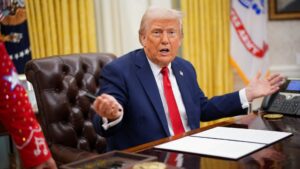The Economic Gamble of Tariffs: What It Means for You
In a bold move that could reshape the landscape of the U.S. economy, President Donald Trump is set to unveil a new approach to international trade through broad-based tariffs on imports. This ambitious plan, coined "liberation day," aims to revitalize the U.S. economy by curbing dependence on deficit spending and ensuring that trading partners like Canada, Mexico, China, and Europe no longer exploit American consumers’ appetite for cheaper goods.
High Stakes and Mixed Sentiments
The stakes are extraordinarily high. Consumer sentiment is currently at multi-year lows, with many households expressing deep concerns about how these tariffs could drive inflation back to uncomfortable levels. Investors, too, are on edge; the prospect of increased tariffs raises the specter of dwindling corporate profits and a challenging environment for the stock market.
Trump’s vision encompasses creating an economy that thrives on domestic production. However, many are left wondering: how will this transformation unfold, and what will it cost the American consumer?
Joseph LaVorgna, a former senior economic advisor to Trump, highlights the inherent complexity of these negotiations. "People always want immediate results and clarity, but negotiations don’t work that way. Good things take time," he explains. LaVorgna remains optimistic about the administration’s ability to deliver on these promises, but he acknowledges that the initial uncertainty is causing market jitters.
Understanding the Tariff Strategy
In essence, the White House plans to impose "reciprocal" tariffs, meaning the U.S. will demand equivalent tariff rates on products it exports to other nations. There’s talk of a 20% blanket tariff, but experts like LaVorgna suggest it will likely stabilize closer to 10%, with China facing potentially exorbitant tariffs as high as 60%.
While the administration’s ultimate goal is to reduce a staggering $131.4 billion trade deficit, the immediate consequences of such aggressive tariffs could be felt across the economy. Not only could this approach lead to job creation in some sectors, but it may also spark significant volatility in consumer prices.
The Inflation Dilemma
Tariffs are often viewed as a tax on imports, leading many to fear their inflationary potential. Historically, during Trump’s first term, heavy tariffs resulted in isolated price increases but did not trigger widespread long-term inflation. However, the current scenario takes on additional complexity, reminiscent of past economic mistakes like the Smoot-Hawley tariffs of 1930 which ignited a global trade war.
Mohamed El-Erian, Chief Economic Advisor at Allianz, counterbalances optimism with caution. "This could be a major rewiring of both domestic and global economies,” he warned. The risk of retaliatory tariffs could plunge the economy into a dangerous phase of stagflation, reminiscent of the perilous 1970s.
The Economic Landscape: Risks and Projections
Although Goldman Sachs initially projected modest economic growth for the year, recent data prompted a downward revision to nearly stagnant growth. Analysts cite declining consumer and business confidence, exacerbated by the looming threat of tariffs impacting spending and investment decisions.
Luke Tilley, Chief Economist at Wilmington Trust, predicts an even higher risk of recession at 40%. "Many businesses are hesitating to hire and invest as the uncertainty looms over their operations," he stated, underscoring that tariffs pose a risk not just to inflation, but to growth itself.
As uncertainty dishes out challenges to consumer behavior and business planning alike, it’s evident that these tariffs might initially inflate prices but could ultimately lead to a contraction in economic activity.
The Road Ahead: Staying Informed
As the economic landscape evolves amid these changes, it’s vital to stay informed. Understanding the implications of such policies not only helps investors navigate potential volatility but also equips consumers with knowledge to make wiser financial decisions.
At Extreme Investor Network, we are committed to providing you with unique insights and analysis that go beyond surface-level reporting. With every twist and turn in the economy, we aim to arm our readers with the tools they need to adapt and thrive in an ever-changing market.
Stay tuned for our updated reports and expert analysis on the unfolding effects of tariffs, inflation, and the broader economic implications on your investments and lifestyle!
By choosing Extreme Investor Network, you gain the knowledge and guidance necessary to make informed decisions in a complex economic environment—because your financial future deserves an expert touch.

